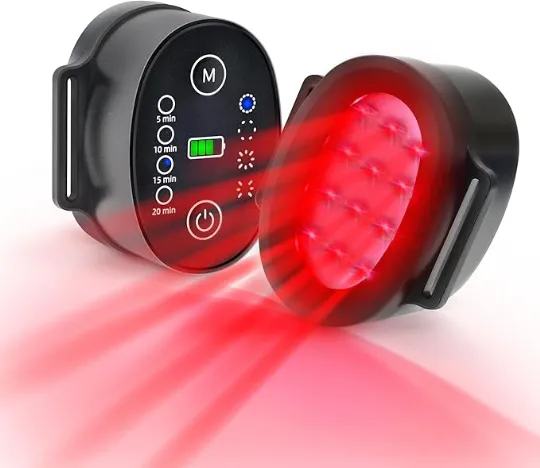Frequent Ailments Treated with Red Light Therapy Dogs
Wiki Article
How Red Light Therapy Can Improve Your Dog's Overall Health
Red Light Therapy has actually become an appealing choice for boosting canine health and wellness. This non-invasive treatment stimulates cellular activity and advertises recovery in pet dogs struggling with various ailments. Numerous pet dog owners report visible benefits, consisting of discomfort alleviation and boosted movement. Recognizing the underlying devices and potential applications is important. What certain conditions can it attend to, and just how can it be safely incorporated into a pet's treatment regimen? The answers might amaze you.Recognizing Red Light Therapy: What It Is and Just how It Functions
Red light therapy has gotten popularity in human medication, its application for canines is increasingly identified for its potential advantages. This non-invasive therapy utilizes certain wavelengths of light, normally in the near-infrared and red range, to stimulate mobile function. The underlying concept includes the absorption of light by mitochondria, which increases ATP manufacturing and boosts mobile metabolism.As an outcome, red light therapy advertises enhanced flow and help in cells fixing. The therapy is delivered through tools such as lasers or LED panels, which can be guided at particular areas of a pet dog's body. Treatment sessions are normally brief, making it a practical alternative for pet owners.
Comprehending this technology's systems can aid caregivers make notified choices concerning their pet dog's health and wellness care. As research study continues to progress, the interest in red light therapy as a complementary therapy method for various canine conditions is likely to expand.

Advantages of Red Light Therapy for Dogs
Red light therapy uses several considerable benefits for pet dogs, consisting of efficient discomfort relief and an accelerated healing procedure. This therapy can enhance movement and adaptability, making it especially important for aging or injured pets. As even more pet dog proprietors look for alternate therapies, understanding these advantages becomes progressively important.Pain Relief Applications
Many canine proprietors are turning to red light therapy as an encouraging service for reducing pain in their pet dogs. This non-invasive treatment makes use of specific wavelengths of light to penetrate the skin, boosting mobile activity and decreasing inflammation. Dogs experiencing chronic conditions such as joint inflammation, hip dysplasia, or post-surgical discomfort may experience substantial relief with this therapy. Researches show that red light therapy can improve blood flow, helping to deliver essential nutrients to influenced areas, further contributing to discomfort reduction. In addition, it might assist to reduce the dependence on pharmaceutical pain reducers, which typically feature unfavorable side effects. Consequently, numerous veterinarians are significantly advising red light therapy as a effective and secure alternative for handling pain in pet dogs.
Accelerated Recovery Process
The benefits of red light therapy extend beyond pain relief, playing a crucial duty in accelerating the recovery process for pet dogs. This innovative treatment promotes cellular regeneration, boosting the production of ATP, which improves energy accessibility for healing tissues. Furthermore, red light therapy raises blood flow, leading to boosted oxygen and nutrient shipment to injured locations. This enhanced circulation not only help in faster healing but additionally reduces swelling, a typical barrier to recovery. On top of that, the therapy urges collagen production, vital for cells repair service and regeneration. In general, by assisting in these biological processes, red light therapy substantially reduces recuperation times, enabling pet dogs to return to their regular tasks faster and with higher vitality.Improved Mobility and Versatility
Improved movement and adaptability are significant advantages of red light therapy for dogs, particularly for those experiencing joint pain or stiffness. This non-invasive therapy utilizes certain wavelengths of light to permeate tissues, advertising enhanced blood circulation and decreasing inflammation. As an outcome, pet dogs typically experience relief from pain related to arthritis, hip dysplasia, or post-surgical healing. Normal sessions can stimulate mobile repair and boost muscle feature, allowing canines to reclaim their natural series of motion. Owners have reported noticeable enhancements in their pets' capacity to run, jump, and take part in activities they as soon as enjoyed (Red Light Therapy Dogs). Eventually, red light therapy not only assists reduce pain yet additionally adds to a much more energetic and meeting way of life for pets, enhancing their general lifestyleConditions That Can Be Cured With Red Light Therapy
Although red light therapy has actually obtained appeal in various fields, its application in veterinary care, specifically for canines, has shown guarantee in dealing with a series of problems. This non-invasive therapy technique is believed to aid in easing discomfort and inflammation related to arthritis, aiding older dogs regain movement. In addition, it has been made use of to assist in the recovery of injuries, burns, and medical incisions, promoting faster recuperation times.Skin problem, such as dermatitis and locations, might likewise respond positively to red light therapy, decreasing irritability and encouraging much healthier hair development. Moreover, the therapy can be helpful for dogs experiencing problems like hip dysplasia, tendon injuries, and muscle strains. By promoting mobile repair work and boosting flow, red light therapy supplies an alternative method to improving the total health of canines, providing relief and promoting a much better lifestyle.
The Scientific Research Behind Red Light Therapy
Red light therapy operates on the principle of photobiomodulation, which entails the application of certain wavelengths find of light to stimulate mobile procedures. These wavelengths, typically varying from 600 to 1000 nanometers, penetrate the skin and are absorbed by mitochondria, the energy-producing components of cells. This absorption enhances ATP production, leading to boosted power availability for cellular features.
Researches recommend that red light therapy might likewise modulate immune responses and assistance total mobile health. By using these organic mechanisms, red light therapy provides a non-invasive therapy alternative that can add substantially to a pet's health and recuperation from different problems.
Exactly How to Integrate Red Light Therapy Into Your Dog's Regular
Integrating red light therapy into a canine's regimen can be an uncomplicated procedure, provided that animal owners approach it with care and consistency. Selecting an appropriate tool is essential, as options variety from portable devices to bigger panels (Red Light Therapy Dogs). Proprietors need to start by presenting the therapy slowly, allowing their dogs to adjust to the light direct exposure. Sessions can be scheduled for around 10 to 20 mins, preferably 2 to 3 times a week, relying on the pet's needs and the advice of a veterinarianSetting a comfortable environment is essential; utilizing a peaceful room where the canine feels loosened up can boost the experience. Throughout the sessions, owners can engage their pet dogs with comforting voices or mild petting to develop a calming ambience. Keeping an eye on the pet's action is crucial to guarantee the therapy is pleasurable and beneficial, ultimately helping to boost their general well-being.
Safety Considerations and Precautions for Red Light Therapy
When taking into consideration red light therapy for canines, safety must always be a top concern to ensure a positive experience. Pet dog owners need to seek advice from a vet before Bonuses starting any type of therapy, especially for canines with pre-existing problems or those taking medicines. It is vital to select gadgets specifically developed for animals, as human devices may not appropriate.Appropriate eye defense is important; both the trainer and the dog ought to put on safety glasses to protect their eyes from possible harm. Additionally, sessions must be monitored very closely to stay clear of overexposure. It is advisable to begin with shorter sessions and progressively increase period based upon the canine's feedback.
Proprietors must also observe their pets for any type of indicators of go to the website pain or negative responses during and after therapy. By complying with these safety factors to consider, red light therapy can be a useful and risk-free alternative for improving a dog's health.
Frequently Asked Inquiries
Exactly how Often Should I Use Red Light Therapy on My Dog?

Can Red Light Therapy Replace Traditional Veterinary Treatments?
Red light therapy ought to not replace standard veterinary treatments. While it might complement therapies by advertising healing and minimizing pain, speaking with a vet stays crucial for detailed care and attending to underlying health issues in canines.Exist Any Negative Effects of Red Light Therapy for Dogs?
Red light therapy for dogs normally has very little adverse effects, such as temporary skin inflammation or warmth at the treatment website. Most pet dogs tolerate the therapy well, but monitoring for any type of uncommon responses is recommended.What Is the Perfect Duration for every Red Light Therapy Session?
The optimal period for each red light therapy session commonly varies from 10 to 20 mins, depending upon the pet's particular requirements and condition. Examination with a veterinarian is recommended to tailor the therapy suitably.Is Red Light Therapy Suitable for All Canine Breeds?
Red light therapy is normally appropriate for most pet dog types. However, specific health problems and sensitivities might influence its applicability. Consulting a veterinarian ensures the therapy is secure and helpful for every details canine.Several dog proprietors are turning to red light therapy as an encouraging option for easing discomfort in their pets. Enhanced flexibility and versatility are significant benefits of red light therapy for pet dogs, especially for those experiencing from joint pain or stiffness. Red light therapy runs on the principle of photobiomodulation, which involves the application of specific wavelengths of light to promote mobile procedures. Research study shows that red light therapy can promote healing, reduce inflammation, and alleviate pain in pet dogs. Red light therapy for dogs typically has minimal side impacts, such as short-term skin soreness or heat at the treatment website.
Report this wiki page